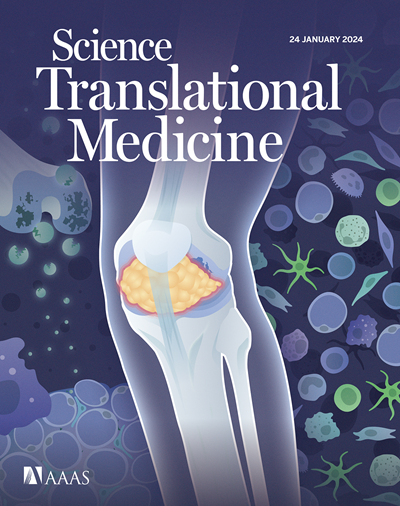MEK1/2抑制剂在细胞模型和人源化帕金森病小鼠模型中抑制病理性α-突触核蛋白和神经毒性
IF 15.8
1区 医学
Q1 CELL BIOLOGY
引用次数: 0
摘要
错误折叠蛋白的异常积累是许多神经退行性疾病的共同标志。在这些蛋白中,α-突触核蛋白(αsyn)是帕金森病(PD)和其他突触核蛋白病的一种已知的致病蛋白。αsyn可过度磷酸化,形成病理聚集,导致神经变性。因此,病理性αsyn的化学调节剂可能抑制其下游毒性,并为治疗干预提供切入点。在这里,我们发现丝裂原活化蛋白激酶激酶1/2 (MEK1/2)抑制剂是野生型细胞中基础αsyn的负调节因子,αsyn预形成原纤维(αsyn- pff)中的病理αsyn诱导神经母细胞瘤细胞系SHSY-5Y、PC12细胞和原代培养的神经元。我们进一步证明了这些抑制剂在PD细胞模型中通过MEK1/2-ERK2下游的激酶PLK2抑制Ser129磷酸化的αsyn (p-αsyn)。我们将人α - syn- pff注入人SNCA纯合敲入小鼠体内,建立人源化PD小鼠模型。在这些小鼠中,口服可穿透血脑屏障的MEK1/2抑制剂可降低病理性α - syn并挽救pd相关表型,且具有可接受的安全性。总的来说,这些数据突出了MEK1/2抑制剂作为PD的潜在治疗策略。本文章由计算机程序翻译,如有差异,请以英文原文为准。
MEK1/2 inhibitors suppress pathological α-synuclein and neurotoxicity in cell models and a humanized mouse model of Parkinson’s disease
The abnormal accumulation of misfolded proteins is a common hallmark of many neurodegenerative disorders. Among these proteins, α-synuclein (αsyn) is a well-characterized pathogenic protein in Parkinson’s disease (PD) and other synucleinopathies. αsyn can be hyperphosphorylated and form pathological aggregates, leading to neurodegeneration. Thus, chemical modulators of pathological αsyn may suppress its downstream toxicity and provide entry points to therapeutic intervention. Here, we identified mitogen-activated protein kinase kinase 1/2 (MEK1/2) inhibitors as negative modulators of basal αsyn in wild-type cells and that pathological αsyn in αsyn preformed fibrils (αsyn-PFF) induced the neuroblastoma cell line SHSY-5Y, PC12 cells, and primary cultured neurons. We further demonstrated that these inhibitors suppressed Ser129 phosphorylated αsyn (p-αsyn) through the kinase PLK2 downstream of MEK1/2-ERK2 in PD cell models. We established a humanized PD mouse model by injecting human αsyn-PFF into mice with homozygous knock-in of human SNCA. Oral administration of blood-brain barrier–penetrable MEK1/2 inhibitors lowered pathological αsyn and rescued PD-relevant phenotypes with an acceptable safety profile in these mice. Collectively, these data highlight MEK1/2 inhibitors as a potential therapeutic strategy for PD.
求助全文
通过发布文献求助,成功后即可免费获取论文全文。
去求助
来源期刊

Science Translational Medicine
CELL BIOLOGY-MEDICINE, RESEARCH & EXPERIMENTAL
CiteScore
26.70
自引率
1.20%
发文量
309
审稿时长
1.7 months
期刊介绍:
Science Translational Medicine is an online journal that focuses on publishing research at the intersection of science, engineering, and medicine. The goal of the journal is to promote human health by providing a platform for researchers from various disciplines to communicate their latest advancements in biomedical, translational, and clinical research.
The journal aims to address the slow translation of scientific knowledge into effective treatments and health measures. It publishes articles that fill the knowledge gaps between preclinical research and medical applications, with a focus on accelerating the translation of knowledge into new ways of preventing, diagnosing, and treating human diseases.
The scope of Science Translational Medicine includes various areas such as cardiovascular disease, immunology/vaccines, metabolism/diabetes/obesity, neuroscience/neurology/psychiatry, cancer, infectious diseases, policy, behavior, bioengineering, chemical genomics/drug discovery, imaging, applied physical sciences, medical nanotechnology, drug delivery, biomarkers, gene therapy/regenerative medicine, toxicology and pharmacokinetics, data mining, cell culture, animal and human studies, medical informatics, and other interdisciplinary approaches to medicine.
The target audience of the journal includes researchers and management in academia, government, and the biotechnology and pharmaceutical industries. It is also relevant to physician scientists, regulators, policy makers, investors, business developers, and funding agencies.
 求助内容:
求助内容: 应助结果提醒方式:
应助结果提醒方式:


